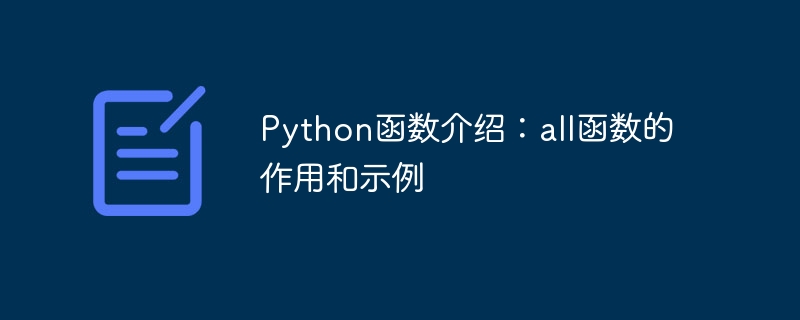Home >Backend Development >Python Tutorial >Introduction to Python functions: functions and examples of all functions
Introduction to Python functions: functions and examples of all functions
- WBOYWBOYWBOYWBOYWBOYWBOYWBOYWBOYWBOYWBOYWBOYWBOYWBOriginal
- 2023-11-04 11:15:111600browse

Introduction to Python functions: the role and examples of all functions
Python is a powerful programming language with many built-in functions, one of which is a very practical function all(). In this article, I will introduce the role of the all function and provide detailed code examples.
all() function is a function used to determine whether all elements in an iterable object are true. "Iterable objects" refer to objects that can be traversed using a for loop, such as lists, tuples, sets, etc. The all() function returns True when all elements are true, otherwise it returns False. The following is the basic syntax of the all() function:
all(iterable)
Let’s look at some examples of the all() function:
Example 1:
nums = [1, 2, 3, 4, 5] print(all(nums)) # 输出:True
In the above example, all elements in the list nums are true values (non-zero integers), so the all() function returns True.
Example 2:
nums = [1, 0, 3, 4, 5] print(all(nums)) # 输出:False
In this example, the second element of the list nums is 0, and 0 is considered a false value, so the all() function returns False.
Example 3:
strs = ['hello', 'world', ''] print(all(strs)) # 输出:False
In this example, the last element in the list strs is an empty string. The empty string is also considered a false value, so the all() function returns False .
Example 4:
empty_list = [] print(all(empty_list)) # 输出:True
In this example, the empty list is considered an iterable object with no false values, so the all() function returns True.
Next, let us show the flexibility of the all() function through more examples.
Example 5:
def has_vowels(word):
vowels = ['a', 'e', 'i', 'o', 'u']
return all(letter in vowels for letter in word)
words = ['hello', 'world', 'apple', 'python']
print(all(has_vowels(word) for word in words)) # 输出:False
In this example, we define a has_vowels function to check whether a word contains vowels. Using the all() function, we can loop through each word in the words list and check if they all contain vowels. Because not all words contain vowels, the all() function returns False.
Example 6:
def is_positive(num):
return num > 0
numbers = [1, 2, 3, 4, 5]
print(all(map(is_positive, numbers))) # 输出:True
In this example, we define an is_positive function to determine whether a number is greater than 0. We use the map() function to apply the is_positive function to each element in the numbers list, and then use the all() function to determine whether all elements are true. Because all numbers are greater than 0, the all() function returns True.
The above are some common usage examples of the all() function. By using the all() function, we can easily determine whether all elements in the iterable object are true, thus simplifying our programming work.
Summary:
In this article, we learned the role and usage of the all() function in Python. The all() function is used to determine whether all elements in the iterable object are true. The all() function returns True when all elements are true, otherwise it returns False. We demonstrate different usages of the all() function through examples, including basic usage and more complex usage. By flexibly using the all() function, we can simplify our code and handle judgment problems efficiently.
I hope this article will be helpful to your learning of Python programming. thanks for reading!
The above is the detailed content of Introduction to Python functions: functions and examples of all functions. For more information, please follow other related articles on the PHP Chinese website!

